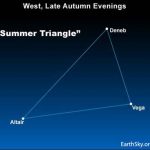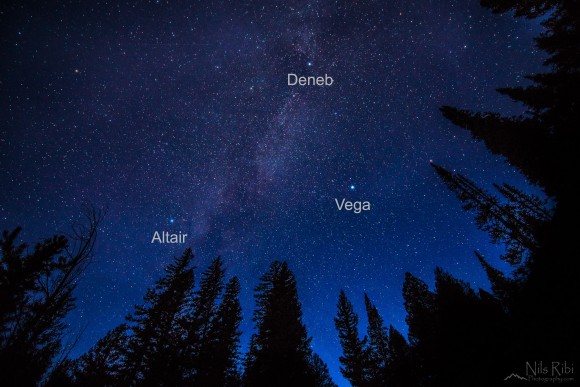
In late November and early December, look west in the evening for the Summer Triangle. It’s the signature star formation of our Northern Hemisphere summer, but you can see it in northern autumn, too. The Summer Triangle showcases three brilliant stars – Vega, Deneb and Altair – in three separate constellations.
What’s more, the Summer Triangle will continue to shine after dark throughout December and even into January. Look for it tonight at early evening, high in your western sky.
EarthSky lunar calendars are available! They make great gifts. Order now. Going fast!
In the month of June – around the June solstice – the Summer Triangle pops out in the east as darkness falls and shines all night long. But now – in late November – the Summer Triangle appears way high in the west at evening. As evening deepens, the Summer Triangle descends westward, with all three of its stars staying above the horizon until mid-to-late evening.
Altair – the Summer Triangle’s most southerly star – will set around 10 to 11 p.m. tonight at mid-northern latitudes. Notice where you see the Summer Triangle at a given time this evening. The Summer Triangle will return to this same place in the sky some four minutes earlier with each passing day, or two hours earlier with each passing month.
As the Summer Triangle sinks close the western horizon around mid-evening, turn around to see Orion – the signpost constellation of winter – rising in the east.

Nils Ribi caught this photo of the Summer Triangle in November 2014.
Bottom line: Look westward this evening for the three brilliant stars of the humongous Summer Triangle: Vega, Deneb and Altair.
EarthSky astronomy kits are perfect for beginners. Order yours from the EarthSky store.
from EarthSky https://ift.tt/2DHdRGT

In late November and early December, look west in the evening for the Summer Triangle. It’s the signature star formation of our Northern Hemisphere summer, but you can see it in northern autumn, too. The Summer Triangle showcases three brilliant stars – Vega, Deneb and Altair – in three separate constellations.
What’s more, the Summer Triangle will continue to shine after dark throughout December and even into January. Look for it tonight at early evening, high in your western sky.
EarthSky lunar calendars are available! They make great gifts. Order now. Going fast!
In the month of June – around the June solstice – the Summer Triangle pops out in the east as darkness falls and shines all night long. But now – in late November – the Summer Triangle appears way high in the west at evening. As evening deepens, the Summer Triangle descends westward, with all three of its stars staying above the horizon until mid-to-late evening.
Altair – the Summer Triangle’s most southerly star – will set around 10 to 11 p.m. tonight at mid-northern latitudes. Notice where you see the Summer Triangle at a given time this evening. The Summer Triangle will return to this same place in the sky some four minutes earlier with each passing day, or two hours earlier with each passing month.
As the Summer Triangle sinks close the western horizon around mid-evening, turn around to see Orion – the signpost constellation of winter – rising in the east.

Nils Ribi caught this photo of the Summer Triangle in November 2014.
Bottom line: Look westward this evening for the three brilliant stars of the humongous Summer Triangle: Vega, Deneb and Altair.
EarthSky astronomy kits are perfect for beginners. Order yours from the EarthSky store.
from EarthSky https://ift.tt/2DHdRGT

Aucun commentaire:
Enregistrer un commentaire